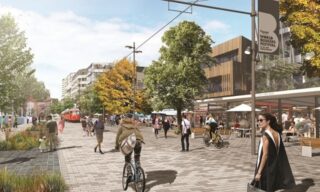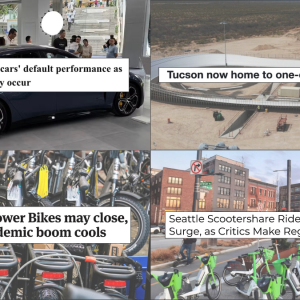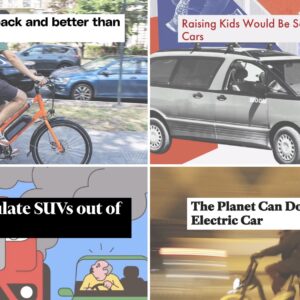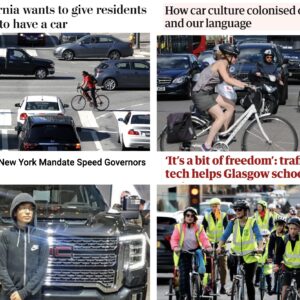
a rebuilt street in Christchurch.
(Image: Christchurch Central Development Unit)
— This week’s Monday Roundup is sponsored by Abraham Fixes Bikes, that great little bike shop on N Williams and Fremont.
Happy Labor Day! Posting will be lighter than usual today in honor of jobs well done. Whatever you’re working on these days, take a moment today to be proud of it.
And now, your regularly scheduled roundup of the bike-related links from around the world that caught our eyes this week:
Bike-friendly rebuild: “You shouldn’t have to have an earthquake for this to happen,” says a transportation engineer from Christchurch, New Zealand, about his city’s return to its biking roots.
Chinese incentives: In China, people are regularly caught on camera deliberately backing their cars over people they’ve already injured, including young children and seniors. The reason: if you injure someone, you support them for the rest of their life, but if they die you’ll often get off.
L.A. riders: “We want to show people we’re not your regular cannabis consumer,” a 25-year-old co-founder of Los Angeles’s Kushtown Society nighttime bike club tells the Guardian of his group’s fast 60-mile rides. “We’re active and athletic.”
Hidden danger: Another week, another article about the supposed risks of biking that fails to consider the risks of doing nothing all day except sit in a variety of chairs.
Cargo bike cost: They cost more than you want them to, but the reasons make sense.
Old vs new: The BBC raced an amateur on a 30-pound cork-braked 1914 two-speed against a pro on a 15-pound carbon-fiber 22-speed, but you have to be in the UK to see the whole episode.
Quality of life: The people of Washington County’s Aloha neighborhood want “bikes, beer and brews” too, says Kody Harros of its business association, but it’s hard to get either without sidewalks and decent bike lanes.
Congestion solutions: The Texas Transportation Institute’s annual fantasy that the next highway lane will be the one that never fills up (also known as its Urban Mobility Scorecard) is as dumb as ever.
Red means stop: Seattle’s Vision Zero plan includes banning right turns on red at 10 downtown corners that saw 140 turning-car collisions in the last three years.
Paint ain’t enough: When you ask people how comfortable they’d be on different sorts of streets, adding a protected bike lane to a four-lane commercial street has seven times the benefit of adding a painted door-zone lane.
Better Census: Our best data source about U.S. biking is seriously flawed. Here are five ways it could improve.
Advertisement
Self-driving systems: “As it turns out, what looks chaotic and random on a city street to the human eye is actually fairly predictable to a computer,” the head of business operations for Google’s Self-Driving Car Project tells advocacy group Bike Austin.
Self-driving challenges: Their main safety problem seems to be sharing the road with human drivers.
Unequal modes: “Flimsy, slow and distracting bikes” “don’t belong on busy city streets,” a conservative Boston Globe columnist informs us.
Florida safety: The state’s upcoming complete-streets implementation plan will encourage both narrower general travel lanes and protected bike lanes.
Underdog heroes: Portlanders Joe Biel and Elly Blue have started publishing a series of short films about remarkable bike advocates around the world. Streetsblog USA has a set of teaser clips.
E-fare transit: TriMet’s push to eliminate paper tickets over the next few years has riders’ advocates worried.
Collision settlement: The family of a Vancouver 11-year-old killed in 2012 by a left-turning bus won a $2 million settlement from C-Tran.
And your video of the week is a profile by regional governent Metro of one of Portland’s front lines for both street improvements and gentrification: the diverse Jade District at SE 82nd and Division. If this doesn’t give you a solid dose of dread, you’re a few steps ahead of us.
— If you come across a noteworthy story, send it in via email, Tweet @bikeportland, or whatever else and we’ll consider adding it to next Monday’s roundup.






Thanks for reading.
BikePortland has served this community with independent community journalism since 2005. We rely on subscriptions from readers like you to survive. Your financial support is vital in keeping this valuable resource alive and well.
Please subscribe today to strengthen and expand our work.
The idea that one should not be able to purchase a fare, in cash, at the point of service, anywhere on our public transit system is preposterous. Advocates, no everyone ought to be concerned, and frankly angry that consultants were allowed to push this ridiculous idea anywhere near implementation.
How much should be spent on collection? Trimet put it at 11.1% of revenue in their white paper on e-fares a few years back. They know their existing network or retail outlets is not sufficient, and plan to add hundreds more stores that will sell cards and let you top up before the e-fare system is launched.
Trimet hasn’t ignored equity issues in the past. That’s why they got rid of the zoned fare system. And are proposing a fare collection system that lets people get monthly/daily pass discounts without having to pay up front.
You already can’t purchase fare at most of TriMet’s broken kiosks.
This. MAX has essentially been cash-free for years. You cannot rely on those TVMs.
story about the google car does not mention whether the car put on its hazard lights when stopping for the pedestrian. a lot of human motorists neglect to do this. might not prevent every rear-ender, but should help.
I’ve never seen or heard of that use of hazard lights. (Is it even legal? ORS 811.515(13)(a)… yes?) I still think it might be safer to activate the “safe following distance flamethrower”.
seems to me like an obvious use. whenever you are about to do something to disrupt the mindless flow, warn other users. big red button, easy to find.
You. Are. Joking.
Nope. To many motorists, seeing the hazard lights means “I’m going to be stopped here a while, probably unable to clear the lane. Go around me.” Using hazard lights in this way WILL get pedestrians killed.
Bike Portland should be taking the day off. Not that I’m complaining, mind you.
Gentrification:
If I’m a baker I buy ingredients at low cost, I bake and then sell then sell the results for profit.
A developer buys real estate as to low(er) costs, “developes” and then sells at a much higher price for profit.
One of these transactions causes economic displacement, the other provides yummy bread and an enticing smell but economically they are the same.
This is Capitalism 101: as long as the property under your feet is seen as a bargaining commodity its economic value is more important than any consequences to the lives of people who live there.
The only thing that could make this paradigm more ridiculous would be if Donald Trump’s last name was “Romanov”. It is like they can’t see where this pattern goes.
land is a finite resource [and property is theft, but that is a conversation for another day. if economics views these two transactions as identical it has a huge blind spot.
]
Technically speaking, flour is a finite resource as well.
You don’t need an earthquake to make bike-friendly streets. Some will, paint, signs, and diverters would do the trick and wouldn’t take 5 years.
That’s 18.6mph aka “twenty is plenty”.
To clarify, the five years is to complete about 70 miles of Dutch-style cycleways around the city (hence the US$100 million pricetag too). Already underway (after two years of detailed planning); the first section was opened last week. Yes, I’m also hoping for a few “quick wins” via paint/signs/etc; indeed, we’re borrowing from Portland’s Neighbourhood Greenways model for our quiet streets.
The Hidden Danger article is yet another write up (from NPR noless) of the same JAMA study from last week.
I wish to repeat that the increase is presented as percentages – ie +300% or tripled. If you look at the real number of incidents is likely we’ve gone from say 50 to 150 a year nationwide for this overly exaggerated age bracket (the norm is 10 year brackets) , meanwhile in this same time period commuter (not overall which is likely even higher) bicycle numbers are up 60+%, and the overall (all ages) incident rate is down 40%.
This is typical safety in numbers, and nothing to really warrant the attention it has gotten.
Though I’m not willing to lay down the $30 for the actual study. I am planning on hitting the library in the next week or so to read it over.
Yet the headline in this blog presents a strawman argument. It’s not a choice between cycling and “doing nothing at all except sitting in a variety of chairs.” I would expect better reportage from BP.org.
I wasn’t arguing that. I just don’t like how these studies put up percentages on incidents which are so small in actual numbers or are really statistically non existent (not to belittle the victims or survivors of traffic violence – obviously 1 a year is too many).
According to WISQUARS (the CDC) there were 259 bicycle unintentional deaths of bicycle riders aged 25+ in 2013.
http://webappa.cdc.gov/cgi-bin/broker.exe
Which means that a tripling would put the number at 86 people aged 25+ year olds that died each year when the study started (1995). (Actually less because I was lazy and didn’t look up those that are only automobile related)
Would the study get such headlines or cause such a ruckus if it said that there were less than 173 more 25+ year olds killed by cars each year when riding bicycles?
Actually what they report is a tripling of the 35-54 age group. Whose total numbers according to WIAQARS for the year 2013 is 73.
Unintentional pedalcyclists is number #17 of the top twenty list of causes of death for this age group. The top 5 are…
1)Unintentional poisoning
2)Unintentional Motor Vehicle Traffic
3)Unintentional Fall
4)Unintentional Drowning
5)Unintentional Suffocation
Honorable mentions to:
9) Unintentional other land transport
11) Unintentional other transport
13) Unintentional Pedestrian
16) Unintentional firearm
Charts on those CDC numbers are here:
http://www.cdc.gov/injury/wisqars/leadingcauses.html
Deeper search forms here:
http://webappa.cdc.gov/sasweb/ncipc/leadcaus10_us.html
I agree with you that the NPR piece does a poor job of putting those numbers in context. Those 73 deaths (20 for 35-44, 53 for 45-54) are out of nearly 36,000 deaths for those ages, contributing 0.1% and 0.3% respectively, compared to over 50% for poisoning and over 25% motor vehicles.
Unintentional Injury, 35-44, Total deaths: 15,354
Unintentional Injury, 45-54, Total deaths: 20,357
That’s true, there are lots of levels of physical activity out there. My attempted point was that the health benefits of physical activity (and therefore the health risks of inactivity) are worth mentioning.
TLDR: cargo bikes cost so much because a cheap gas pipe singlespeed (SE Draft) starts at $259 but it starts adding up when you add the complexity of a larger, more durable frame, derailleurs, decent brakes, and value propositions like wheel skirts, generator lighting, etc. The payoff: exercise and cheaper maintenance.
TriMet’s move to e-fares is long overdue. OPAL is probably right that there should be a low-income fare program, but the rest is nonsense. The $3 card is faster, more convenient, and in the worst case scenario losing one costs fifty cents more than a lost transfer ticket, but it’s a considerable savings with a pass of any sort. Plus you never have to take the thing out of your wallet, so it’s not getting lost in a pocket.
Jeff Jacoby—pfffft!
How many false comparisons and bogus assumptions can someone make in one article? That whole Boston Globe “piece” is one big logical fallacy.
Wow, the pro-separation folks are up to interesting tricks. Creating a false dichotomy of door-zone bike lanes, something no non-suicidal experienced cyclist would ride in, and “protected” bike lanes is disingenuous at best. I guess the success of German cities in successfully inducing more cycling (hey, we could use some of that success) by replacing their separated facilities with two meter+ bike lanes means we have to take that much better (imo) alternative out of the discussion.
Cheaper, faster, both in terms of actually getting them in place and in terms of riding speed, similar at appealing to non-cyclists and just plain better for those who ride isn’t a bad thing. Separation shouldn’t be an end in itself, especially considering the intersection issues.
It’s sad to me that some people are so focused on “winning” separation that we can’t unite to fight the real battles: On-street parking, traffic law enforcement, licensing standards, license revocation standards and such.
I mentioned this in some other comment thread, but isn’t there any way to combine “open” (non-gauntlet-style) painted—even buffered—bike lanes with some kind of “protected” intersection? Aren’t intersections where the real danger lies for bicyclists? And isn’t the danger magnified when cyclists are hidden from view prior to arriving at the intersection? Wouldn’t an already-visible bicyclist arriving at a “protected” intersection be the safest of all? I don’t understand the obsession with mid-block protection when it is intersections and driveways that pose the greatest risks.
If I were dictator, I’d bring painted bike lanes up to standards, figure out how to separate peds and cyclists on “bike paths”—where separation would actually do the most good—and build protected intersections where they were warranted by data. I’d also try to find places where “bicycle superhighways” could speed and ease bike travel around the metro area, repeal ORS 814.420 and take steps like Seattle to prohibit right turns on red at dangerous locations. I’d probably do other stuff, too, but i’d start here.
Definitely – Falbo-style protected intersections are 100% compatible with buffered bike lanes.
They may be compatible with protected bike lanes, but they certainly maintain the “intersection problem”. The exact nature of the problems they bring depend on the traffic engineer implementing them since the various signal possibilities change what happens.
However, no matter what choices are made with the signals, all of them introduce pedestrian/cyclist conflicts at the intersection, which just happens to be where cyclists really don’t need an additional conflict coming from all angles while they deal with whatever other treats are in store. If the lights add extra phases, which adds time to everyone’s trips (and thus may not be allowed under “level of service” engineering doctrine), then the only added risk is the right hook by a scofflaw motorists who definitely won’t be scanning the side-path for conflicts since the bikes approach from a place that is out of sight for a right-turning motorist (no matter what the silly videos on this say; look at where motorists actually look when turning right!).
If extra phases aren’t added, then we have both added right hook and left hook risks plus the added risk of traversing the intersection twice for each left turn (and waiting for at least one red light). I particularly hate signal phasing that gives bikes a head start. That’s all well and good until you’re the cyclist who didn’t have to wait at the signal.
However, even with all those objections based on safety, my biggest concern is that if these are implemented they will set a very low cap on the top end for cycling modal share here. They just don’t allow for enough space for a large modal share to use these intersections. Seville, Spain has put in a large segregated network and was all pleased with itself as the city quickly grew to 6% bike share. Four years after achieving 6%, they are still at 6% (sound familiar?), which is even worse than I predicted at the time based on the overly-constricted space allocated to bikes relative to cars.
“…Creating a false dichotomy of door-zone bike lanes, something no non-suicidal experienced cyclist would ride in, and “protected” bike lanes is disingenuous at best. …” b carfee
Suggestions that bike lanes installed directly next to parking areas of roads, and main lanes, are “…door zone bike lanes…” is a misnomer. People riding, according to Oregon bike related laws, do not actually have to ride in bike lanes sited immediately adjoining parking strips and main lanes, is doing so represents a hazard to their safe travel. They can ride any portion of such bike lanes, where cars or other obstacles are not present, that is out of the door zone. Or they may rightfully ride the main lanes, if need arises.
Particularly in parts of already built up cities such as Portland’s older neighborhoods, and Downtown, there aren’t endless amounts of road right of way upon which to install variations of protected bike lanes.
“We want to show people we’re not your regular cannabis consumer,”
Which goes to show that he actually buys into the very stereotypes that he is attempting to counter.
There is certainly a large subculture of cannabis users that is obvious to the non-using public. It probably started being peripherally socially acceptable with Cheech and Chong.
Because it has recently (historically) been illegal there has been social safety in adhering to the social “standards” set by this Kush Klatch.
The examples stereotypes are abundant in reality because despite many, many cannabis users being unnoticed most people can’t stand to keep a secret and intentionally seek out accepting social groups. As long as cannabis remains illegal the 420th Blunt Battalion will remain wicked strong… but generally relaxed.
Saturday afternoon while returning from a training ride I was passed by a green Explorer with pot smoke wafting out of it. I had to laugh because I caught up and stood next to him at a long light, and happened to check my bike computer for some averages… when I noticed it was exactly 4:20 PM.
2015 Ride the Rim at Crater Lake will be on Saturdays, 9/19 & 9/26. Details:
http://ridetherim2015.com
Here is a guide for how to do it: http://bikeportland.org/2014/09/25/guide-ultimate-carfree-crater-lake-rim-ride-111444
Critical mass bicyclist arrested for hitting a car with a U-lock all over the news in SF bay area:
http://abc7news.com/news/neighbors-stunned-after-sf-man-arrested-for-critical-mass-attack/973365
Congratulations, China. You’ve taken the U.S.’s own perverse “driving privilege is paramount” attitude to the most obscene level. Next step, a country that enacts and actual Death Race 2000.